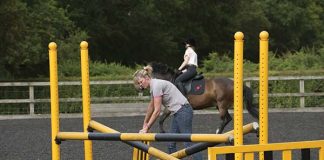Q: What exactly are capped hocks and is there any treatment available? Will the swelling ever go down?
A capped hock appears as a swelling over the point of the hock and will be soft at first, but becomes firmer over time. Usually this condition does not result in lameness unless other injuries or complications are present. Occasionally a capped hock, if chronic and poorly managed, can progress into an abscess, indicating bacterial infection.
If a capped hock is caught early in the acute phase of swelling, it is more receptive to treatment. Repeated applications of cold water hosing at the initial time of injury may help decrease the swelling, followed by pressure bandaging and topical administration of a counterirritant such as DMSO. Stall rest is commonly prescribed, although some studies show that pasture turn-out is acceptable as well. Depending on the size of the swelling, aseptic drainage with a needle followed by injection of a corticosteroid into the bursa may also help. If this is the horse’s first capped hock and treatment is instituted rapidly, chances of resolution of the swelling are fairly good.
Older injuries are less responsive to treatment and may incur a certain amount of swelling that never resolves. This is due mainly to the fact that as a bursa remains inflamed, fibrin is deposited around it, which is a very firm and tough type of connective tissue. Chronic capped hocks will not respond to cold hosing or pressure wraps and, if they are causing pain or interfering in other ways, may only be responsive to surgery, where complete debridement of the bursa and full drainage can be obtained. If surgery is pursued, the horse will likely be on strict stall rest for a period of time to help joint healing and reduce the chance of infection.
The best course of action for a horse with either recurring capped hocks or an initial case is to identify the cause in order to minimize the chance of the condition appearing again. If the horse habitually kicks the stall or trailer walls, if possible, keep the horse on pasture or consult a trainer about re-training the horse out of this destructive and potentially dangerous habit. If the horse is stalled, ensure the bedding is sufficient enough to allow for adequate cushioning when the horse lies down and that the stall itself is large enough so that the horse is not excessively banging himself when he lies down and rises again. Some horses lie down in their stalls much more frequently than others and these animals may be more prone to capped hocks, as well as capped elbows. In the case of capped elbows, a shoe boil roll can be worn by the horse to help prevent this condition. Unfortunately, there is no such equipment designed to help prevent against capped hocks.
— Anna O’Brien
Ask your questions on the HorseChannel.com Forums >>
See more Expert Q&As >>
Submit your Ask the Expert question >>







Thank you for the good information.
I never knew this. 🙂 good article thank you.
I have seen a gelding with a swelling back hock, and now I wonder if this was his condition. It was at a sale.
Good to know. Love these types of articles.